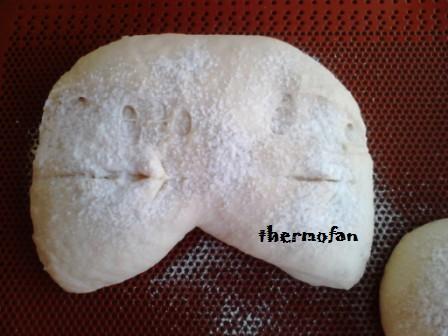Pataqueta. Valencia’ Orchard traditional bread November Baking Partners challenge
Dear Baking Partners here is this month challenge, and we are going to make traditional Spanish bread. Since Thanksgiving is coming in this month we can use this bread for our dinner tables too. Marisa (Thermofan) suggested the recipe. You can also make this bread using whole wheat flour. I have included few more shapes to make this bread. Make sure you make few of traditional versions and with the rest of dough you can make few other shapes too if you are interested.
According to Marisa words,
I’m glad to present this traditional bread from Valencia, known at least since the Seventeenth Century. The Pataqueta, diminutive for “pataca” has the shape of a crescent Moon. This is the bread the inhabitants of the Valencia’s Orchard used to eat when they went to work. It was firstly baked in the Moorish oven they have in their Barraca and then in wood stoves.
Nowadays, it is not frequently baked and people book it in advance to get one. “Pataquetas” are usually baked for our main important festival, “Fallas”. Most of Valencia’s bakers are asked to bake “pataquetas” every year in March.
As a member of Baking partners, I asked Swathi Iyer to collaborate with a recipe from my country. My idea is to spread the word and make known this original and unknown bread. Swathi agreed and I think she is as enthusiastic as me. I hope that everyone who bakes “pataqueta” enjoys it as much as me and what is the most important for me, is to RESPECT the origin of the bread and its shape when publishing it.
The recipe is adapted from here “Entre cacerolas”. This bread has a soft crumb, a firm crust and its taste is the taste of ancient bread.
Ingredients
For the ferment
You will need
100 ml water
50 g /1/3 cup white flour ( Use allpurpose flour/Maida)
12.5 g fresh yeast/5g or1 ½ tsp Instant yeast/6.25g or 2tsp active dry yeast
1/2 teaspoon sugar
Bread dough
You will need
450 g/3 cup strong bread flour (substitute with all purpose flour/Maida)
200 ml tepid water
10 g/1 ¾ teaspoon fine sea salt
all the ferment
a little flour for dusting the work surface and the bread.
Directions
Ferment
Stir the yeast into the water in your mixing bowl, then add the flour and sugar and mix well. Cover with plastic film.
Put into the fridge overnight or up to 48 hours. *
Bread dough
– Keeping the ferment in its bowl, add the rest of the ingredients except the salt, and mix together with your scraper.
– When everything starts to come together into dough, turn it out onto your work surface (don’t flour it first).
– Start to work the dough for about 10 minutes, then add the salt and continue kneading until smooth and elastic. In this process, I’ve used my bread machine.( You can also knead by hand or use stand mixer)
Divide dough into 150 g pieces and then form the dough into small balls, cover with a baking cloth and leave to rest for 20 minutes or until them double in size.
–
Flatten with the palm of the hand, putting more pressure on the edges of the dough to get a rounded shape.
– Then with a sharp knife or baker scraper make a cut in and cut open from the outside. Flatten the ball and mark the cut above.
– Place them on a baking tray and cover them again with a kitchen cloth dusted with flower.
– Leave to rest until them double in size, for about 1 hour.
– Preheat the oven to 200º C / 392 F. –
–
Make two cuts on the bottom before baking.
– Sprinkle a little fine flour using a sieve or strainer.

– Bake with steam, 30 minutes at 200 °C / 392 F.
– Cool on a wire rack.
Tips:
*Following Richard Bertinet advices, it is preferable to introduce the ferment in the fridge than leaving it at room temperature: “the slower the maturation the better developed the flavor and characteristic crumb and crust of the bread”.
– The amount of flour can vary depending on the type of flour that we use. The dough should not be soft.
– My pataquetas are of medium size. It can be made smaller or larger.
– Pataquetas can also be frozen.
– I’ve used my bread machine, but I’m willing to find time to experiment with the traditional method inspired in Richard Bertinet tips on how to work the dough.
Videos
Shaping my pataqueta
Professional shaping. Start from minute 4. (in Spanish)
For making other roll shapes please check here
Pretzel sandwich rolls
Hoagie roll shapes
http://www.asweetpeachef.com/bread/hoagie-rolls/

